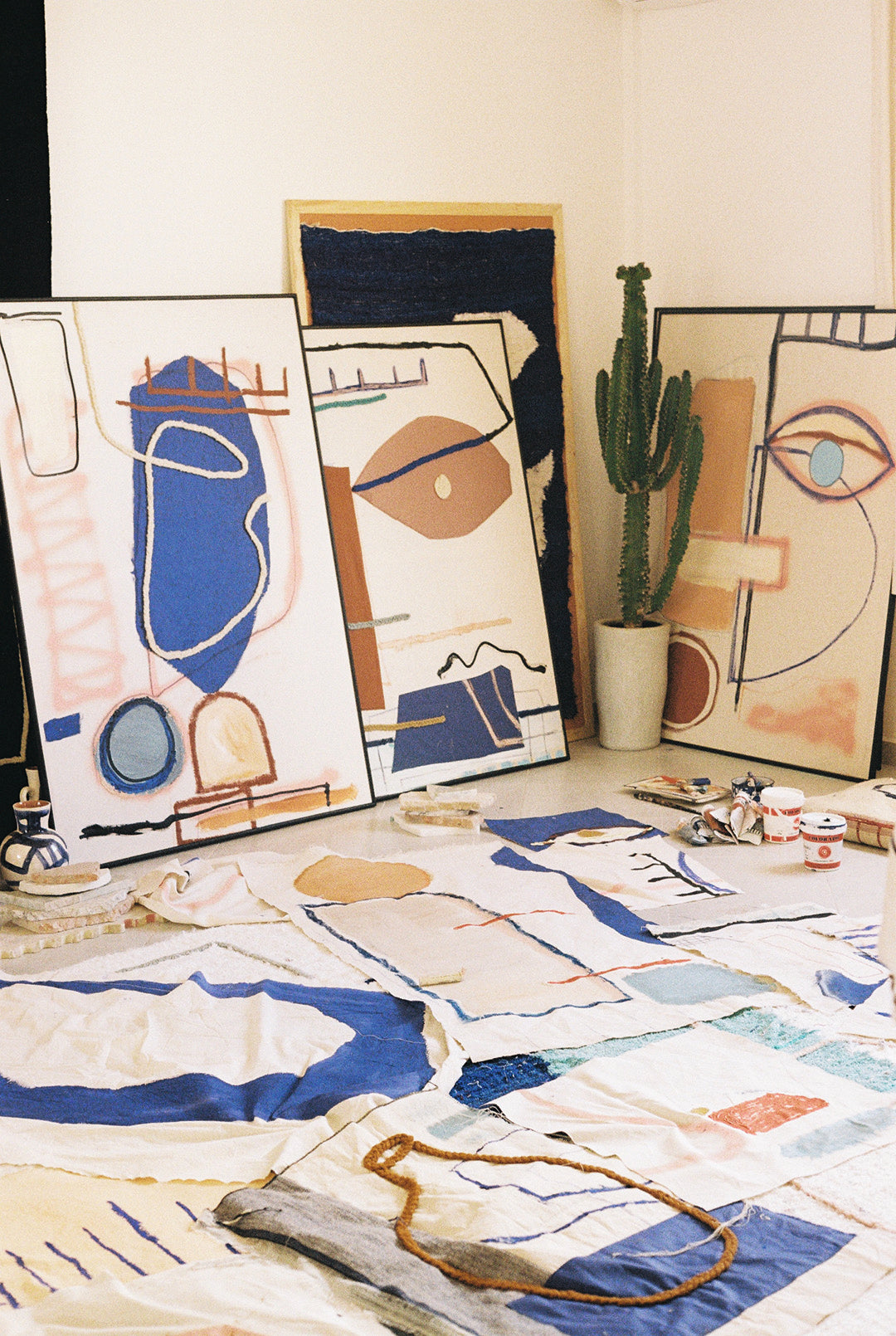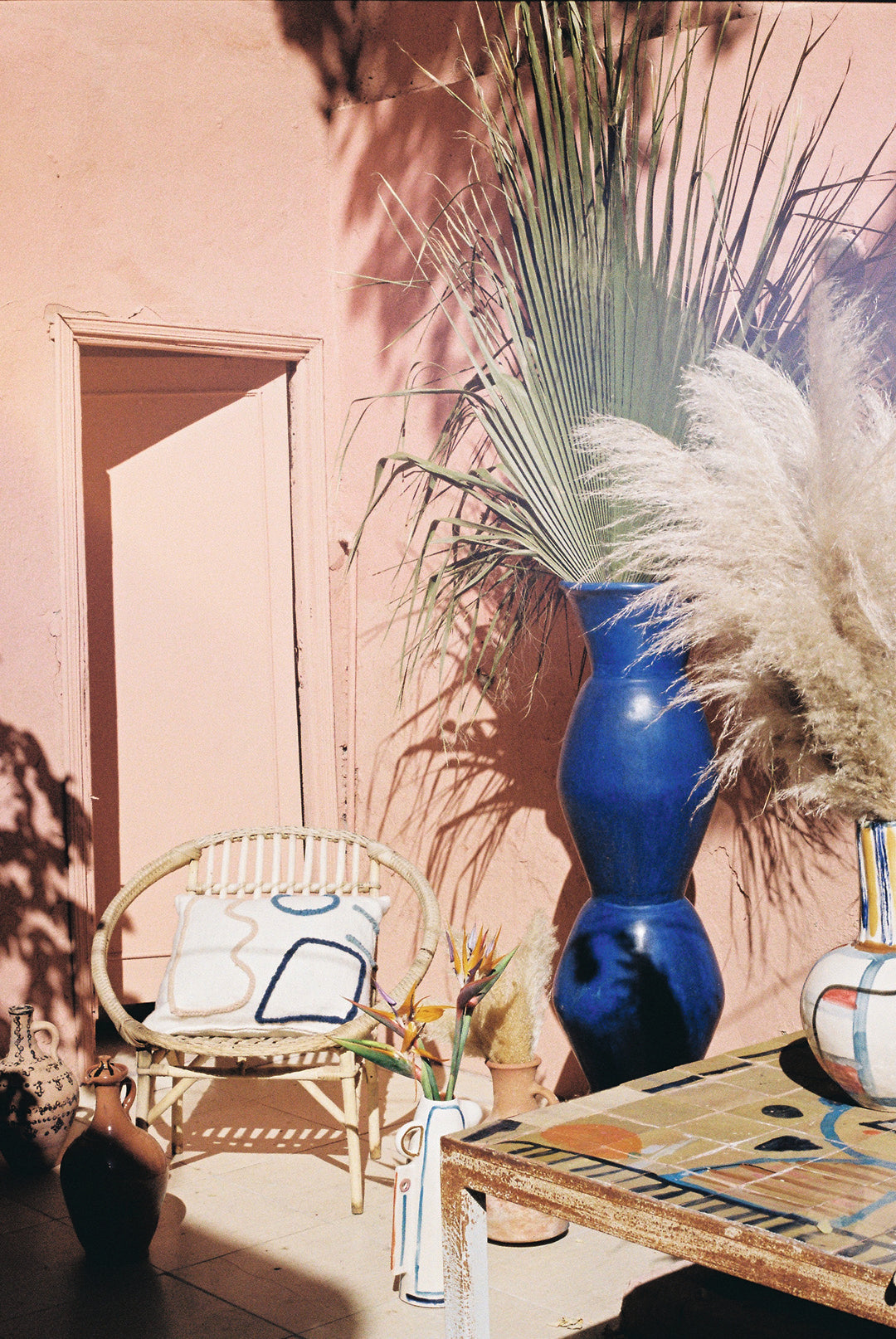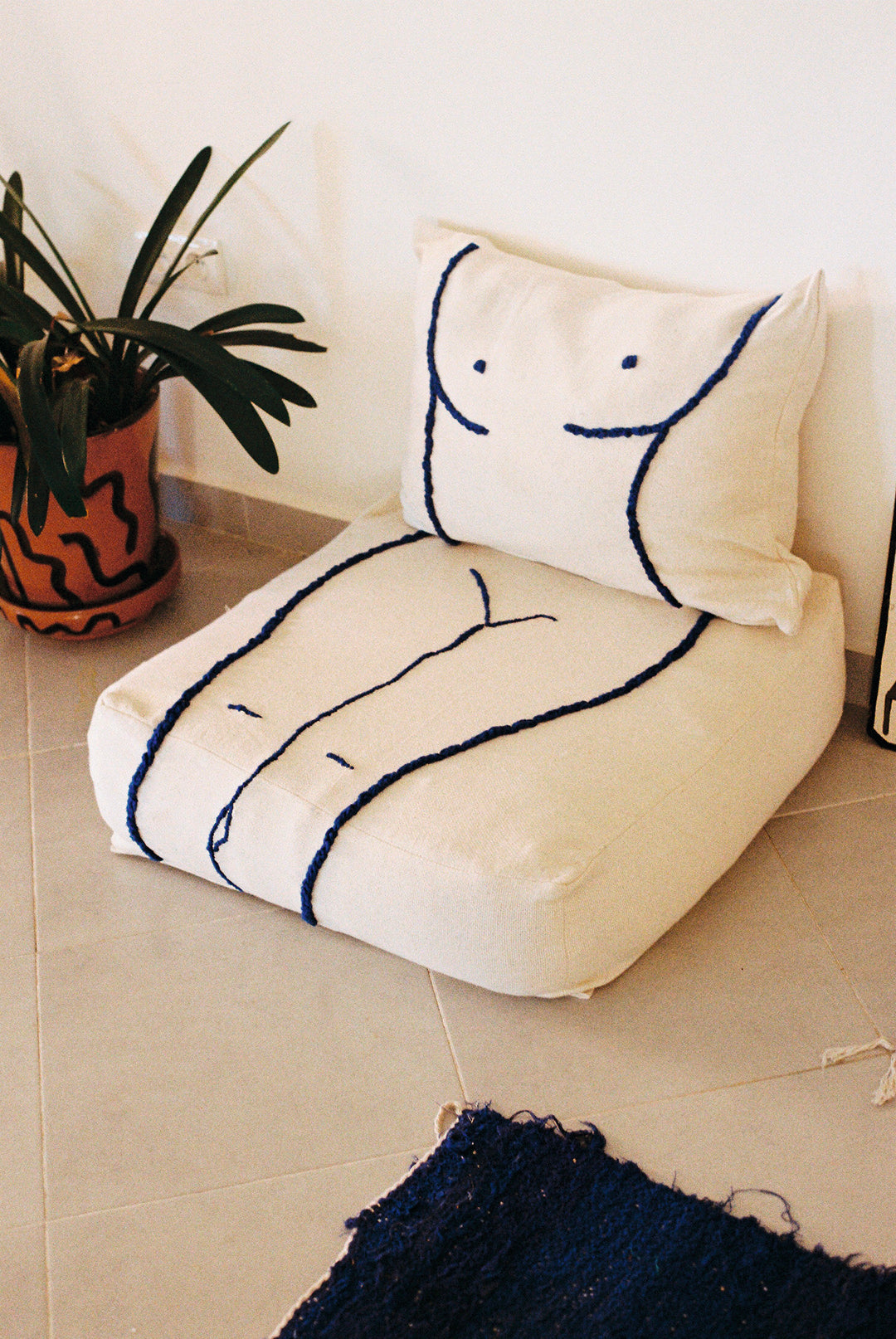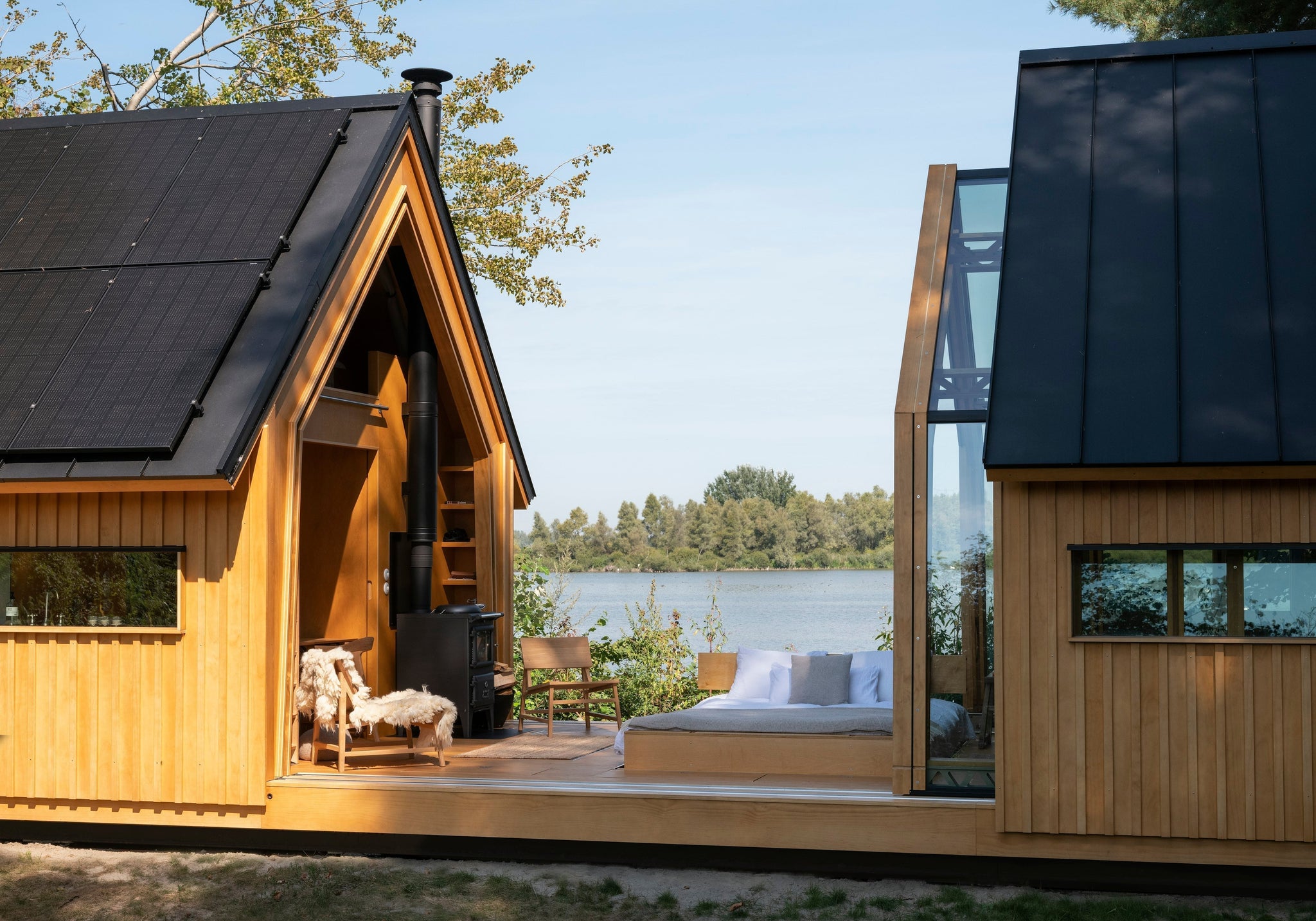
09/2019 architecture & interior
Deep in the labyrinth of hidden passages inside the Medina of Marrakesh lies century-old leather crafters who have carved a global reputation for themselves through their expertise. This ancient artisan tradition is what lured Belgian designer Laurence Leenaert and her brand LRNCE to Morocco. Keeping with traditions and respecting local levels of production, she has developed a sought-after label that doesn't conform to consumer demands.

Framed works are made from naturally dyed wool, then embroidered by hand onto an off-white wool canvas. (Photo: Courtesy of LRNCE)
In The New Mediterranean, Leenaert explains how visiting Marrakesh with her sister exposed her to "rich craft traditions," giving her a fresh perspective on design and production.
LRNCE was founded after Leenaert dropped out of her Master's at the Royal Academy of Fine Arts, Ghent. The original concept was to specialize in leather bags, but the rich pool of experts in Marrakesh allowed for expansion. LRNCE has grown to include ceramics, textiles, sandals, mirrors, wall hangings, and kimono coats.

The color palette is derived from the Moroccan surrounding, free-flowing forms are applied across textiles, ceramics, art, and apparel. (Photo: Courtesy of LRNCE)
Reflecting on her decision to relocate in the book, Leenaert says it came "at a time in my life where I had no attachments in Belgium." Creatively she felt frustrated and limited, with the connection to her place of birth lost—moving to Morocco brought new prospect and perspective.
"It was complicated for me to get samples back in Belgium as they’d need to take a big order, there is a lot of paperwork, for me, it was a struggle"
"When I moved here, I promised myself I would be very open to trying whatever I want, and that I wouldn't put myself in a box." Eventually, an artisan asked if she would like to make sandals. "And I was like, 'Why not!'" She goes on to explain that once you know one good artisan in Marrakesh, it is only a short time before you meet another and another.
Leenaert was introduced to new disciplines, invited to converse over couscous with artisan families, and experienced a new quality of life. She now works with a team of 35 artisans on LRNCE’s production, nine of which work in her design team in the Medina.

The Marwaa two-part pouf: handwoven in Marrakesh by local craftspeople with irreverent design by Laurence Leenaert. (Photo: Courtesy of LRNCE)
Blending traditional Moroccan techniques with modern European experimentation, it took time to convince those tied to rich Morrocan craft traditions about her vision. From teacher to tastemaker, overtime Leenaert turned heads in the Medina with regards to her aesthetic. We find out more about the designer’s decision to head south to the Mediterranean.
“There’s so much freedom here. If you’re creative, it’s endless,” is how you describe Morocco in The New Mediterranean. Can you describe this freedom and why you think it is so much more open than Belgium?
Because a lot of people are independent here, they are working in handcrafts and very open to making samples and with the motto ‘everything is possible.' It was complicated for me to get samples back in Belgium as they’d need to take a big order, there is a lot of paperwork, for me, it was a struggle, here things are so easy.
"Some people don’t understand our mentality sometimes, they don’t understand why we don’t want to do business and why we just don’t produce a lot"
You pay homage to Moroccan craftsmanship but don't try to reinvent traditional design, something which you’ve said has confused local artisans. Has the Medina warmed up to your vision?
Oh yes, for sure, it took some time, but it’s amazing how you can open peoples minds without actually talking or convincing them, just by working and creating together with their view. The aesthetics change, which gives me a really good feeling!
What is the Moroccan state of mind to you?
'Inchallah,' which means 'if God wants.'

Details from the LRNCE studio. "It's very open, everyone sees each other," she says. "I feel the artisan vibe, but still it's modern." (Photo: Courtesy of LRNCE)
The Marrakesh market is sometimes flooded with dealers who buy things to later sell in France, Belgium or the United Kingdom at a huge markup. This isn’t your approach. You have developed a more humane connection with local artisans. How does this affect your business and benefit the local community?
We can’t take a lot of wholesale orders as we don’t want to over-produce. We want to keep it small (keeping the team of artisans and not changing to bigger scale production), so we have to disappoint a lot of people who want to sell our products in their store. But I prefer to not sell and keep something niche than to do large production and make money. Some people don’t understand our mentality sometimes, they don’t understand why we don’t want to do business and why we just don’t produce a lot if we can sell a lot. But I’m not at all interested in this, it takes all the magic away.
With echoes of Pablo Picasso and Joan Miró, how would you describe your aesthetic and what LRNCE stands for?
People are indeed linking me to those amazing artists, but I think I’ve built my world and aesthetic and I want to go away from those ‘echoes.’ I have my way of working and view on how I want to run my brand.
Happiness, joy, a piece of Morocco in an object. Sourcing materials and handmade in Morocco, working together with the artisans, building a team in Marrakesh with the best people and working on LRNCE, it’s the whole spirit and world here. Combining the right colors to create something stronger, changing the Moroccan traditions into something newer.

Leenaert spends her mornings working from her studio, before heading out in the afternoons to meet with the artisans. (Photo: Courtesy of LRNCE)
How has your time at Bless and living in Berlin altered the way you look at the fashion industry model?
Bless was anti-advertising and branding-not only in fashion, which made it very interesting for me, but also the way they look to products and objects. They also make installations, books, bedsheets, and hammocks. It was great to see and learn how this company was running their business and keeping it real—not putting themselves in a box like they only do 'fashion.'
Brands and creatives have a mixed relationship with social media but it has been influential to LRNCE. How powerful has Instagram been in communicating your message and vision?
Instagram has been very important, it’s crazy! For reaching people alone it has been helpful, to show people what we are doing all over the world. We receive people from everywhere in our studio, thanks to Instagram. Sometimes I’m very amazed by the power of Instagram, I went to Cape Town last year and so many people knew LRNCE. I’m very visual and Instagram is perfect to show your world.
What can we expect from you in the next two years?
I’m not a planner, I take things as they come.
Get to know a new Mediterranean aesthetic and creative way of living.














